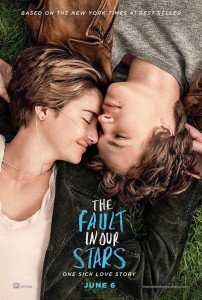 The Fault in Our Stars
The Fault in Our Stars
Starring Shailene Woodley, Ansel Elgort, Laura Dern, Nat Wolff, Willem Dafoe and Sam Trammell
Directed by Josh Boone
From 20th Century Fox
Rated PG-13
125 minutes
Woodley turns in lovely performance in Stars
by Michael Clawson of Terminal Volume
The Fault in Our Stars is a compendium of dying-people clichés. You’ve seen and heard all its parts scattered throughout other films, but here they are all together in one place — a junk drawer labeled “cancer.”
This isn’t meant as an insult, just an observation of the film’s inclusion, and then re-tooling, of all those sick-people scenes that other movies perpetuate, from the first ominous cough to the agonizing funeral. But that’s why John Boone’s film, based on John Green’s hit young adult book, is a deeply moving and beautifully written piece of humanity: it’s not just a strummer of heartstrings, but a delicate examination of young people as they maneuver through the final chapters of their lives.
We begin with teenager Hazel, our narrator and star. She’s cancer-free thanks to an experimental drug that has permanently eradicated the cancer, but rendered her lungs terrifyingly fragile. She must breathe from an oxygen tube that snakes around her ears and under her nose, an accessory she wears well. The oxygen tank is in a cute little rolling backpack she tows at her heels, her life-giving trailer. Although her health is good, Hazel is a broken soul: her sickness has made her cynical and depressed, and she’s slowly spiraling into a void. When she stands up at a survivor support group, she tells everyone that “oblivion is inevitable.” Her doctor wants to prescribe her an antidepressant. She resists: “Depression is a side effect of dying.”
Hazel is played with astounding confidence by Shailene Woodley, an actress who seems to have no limitations. Fault in Our Stars shows her simply and exquisitely: her hair is short and simple, her makeup is minimal, her actions are muted and hushed. But there is never a single moment that Woodley does not own the screen. Her Hazel meets Augustus (Ansel Elgort), an eccentric older boy who was robbed of one of his legs by cancer. Gus, as he’s called, is the opposite of Hazel: confident, bright, smiling, and eternally hopeful. In an unfortunate quirk serving as a metaphor, Gus walks around with a cigarette in his teeth. He doesn’t smoke it, just chews on it, because by not lighting it he’s taking away its power. (Nevermind that he funded big tobacco for that privilege.) He’s especially kind to his best friend, who’s about to lose his eyes to cancer. When the friend is dumped by his girlfriend, Gus gives him his basketball trophies to smash in a cathartic rage.
Gus and Hazel meet at their support group — colliding in a trademark Meet Cute — and they start dating. “I fell in love with him the way you fall asleep: slowly and then all at once,” she says. His infectious smile seeps into her life, and before she knows it, she’s happy and invigorated — her outlook brightens. Aside from her failing health, and his upbeat spirit, the film spends a great deal of time worrying about author Peter Van Houten, who wrote Hazel’s favorite book, An Imperial Affliction, about a cancer patient. After Gus and Hazel start an online correspondence with Van Houten (Willem Dafoe), they travel to Amsterdam to meet him and get answers about his cryptic novel, which ends mid-sentence, signifying the character’s sudden death. Of course, they show up and Van Houten isn’t what they thought, which sends them on a detour through the Anne Frank house and other gorgeous locations.
This is what happens in The Fault in Our Stars, but this is not the core of the movie. Within the scenes, and the loosely thatched plot, is a dialogue to young people about their mortality, their love and their fragile hearts. Hazel and Gus ponder their existence, the eternities, cancer … they seem to be struggling through a thoughtful analysis of the entire universe, stars included. The dialogue is smart and engaging, and the characters are informed and intelligent. They act and talk like adults, a believable aspect to young people who have encountered adult-sized illnesses. This might all sound very existential and ambiguous, and it is because the film wants you to sort out what it all means — life, love and death.
The movie has a grim style of comedy; gallows humor is probably the right classification. At one point, someone says the word “cancertastic.” Later, Hazel and Gus take a blind friend to an ex-girlfriend’s house so he can chuck eggs at her convertible. Van Houten is awkward and awful, even as he blasts Swedish hip-hop for his new guests. Cancer seems to hang over everyone, yet they have to smile and push forward under that gloomy cloud. Such is life.
The Fault in Our Stars is not a reinvention of teen dramas — it’s certainly no dismal Nicholas Sparks book — but it does take great care in trying to understand teens and their hopes, dreams and fears. Teens aren’t the idiots that movies make them out to be. They yearn for smart movies as much as adults, if not more so.









